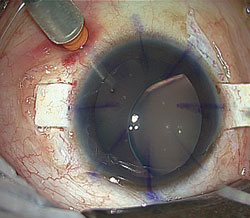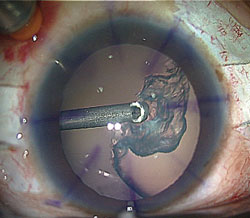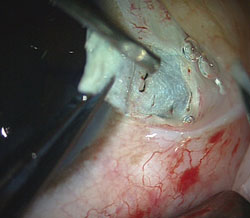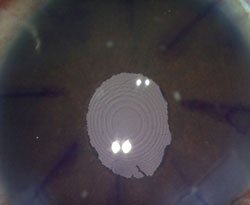Glue technique allows implantation of multifocal IOLs in eyes with deficient capsules
The procedure imparts both distance and near vision in eyes requiring complicated cataract surgery.
Click Here to Manage Email Alerts
 Amar Agarwal |
Although commonly available monofocal IOLs provide a clear point of focus in the distance or closer, only one focal point can be chosen. Multifocal IOLs allow good vision at a range of distances. They are designed to avoid the need for glasses by providing two or more points of focus. These IOLs are intended to be placed in the capsular bag.
Until recently, it was difficult to provide multifocality for patients who require complicated cataract surgeries and lack normal capsules. Aphakia with deficient capsule has been a limitation for obtaining multifocality. We have made multifocality possible even in complicated cataract surgeries with the multifocal glued IOL procedure. In this technique, multifocal IOL implantation is done even in eyes with large posterior capsular rupture and aphakia with deficient posterior capsule.
Multifocal IOL types
There are two types of multifocal IOLs: refractive and diffractive. Refractive IOLs are used for individuals with cataracts and presbyopia. They contain multifocal zones for near, distant and intermediate powers. ReZoom (Abbott Medical Optics) is a refractive IOL. The Array SA40N (AMO) is a foldable progressive multifocal IOL with a 6-mm optic with five concentric refractive zones for near and distance powers. Zones 1, 3, and 5 are distance-dominant to form the base power, and zones 2 and 4 are near-dominant with 3.5 D added. The Tecnis ZM001 (AMO) is a foldable diffractive IOL with a 6-mm optic. It combines diffractive optic technology with an aspheric modified prolate anterior surface that is designed to reduce spherical aberrations.
Multifocal glued IOL technique
Two partial-thickness scleral flaps about 2.5 mm × 3 mm are created exactly 180° diagonally apart. Either an infusion cannula (a 23-gauge sutureless trocar and cannula can be used) or an anterior chamber maintainer is fixed (Figure 1). Anterior vitrectomy is performed in eyes with vitreous traction (Figure 2). Two straight sclerotomies with a 20- or 22-gauge needle are made under the existing scleral flaps about 1 mm from the limbus. The multifocal refractive or diffractive IOL is introduced through the limbal incision using either McPherson forceps or an injector. End-gripping 25- or 23-gauge microrrhexis forceps (MicroSurgical Technology) are passed through one of the sclerotomies (Figure 3) to hold the tip of the haptic. The haptics are then externalized under the scleral flap. A scleral tunnel is made with a 26-gauge needle at the point of externalization of the haptic, and the haptic is tucked into the intralamellar scleral tunnel. The scleral flaps are then closed with fibrin glue (Tisseel, Baxter) (Figures 4 and 5). The infusion cannula or anterior chamber maintainer is subsequently removed. The conjunctiva is also apposed with the fibrin glue.
 Figure 1. Coloboma of the lens. Note the scleral flaps 180° apart, as well as the 23-gauge sutureless trocar and cannula. |
 Figure 2. Lensectomy with vitrectomy. Images: Agarwal A |
 Figure 3. IOL haptic is externalized with 23-gauge MST forceps below the scleral flaps. Both the haptics are externalized below the flaps. |
 Figure 4. Haptics are tucked into the intralamellar scleral tunnel, and then fibrin glue is applied to appose the scleral flaps. |
 Figure 5. Multifocal glued IOL in place. |
Surgical and visual results
We have operated on five eyes: three with refractive IOLs and two with diffractive IOLs. The indications were intraoperative large posterior capsular rupture in three eyes and aphakia in two eyes. The mean preoperative best corrected visual acuity was 0.73 D ± 0.28 D, and the mean postoperative uncorrected visual acuity was 0.76 D ± 0.22 D. The mean postoperative BCVA was 0.86 D. The mean postoperative IOP as noted with non-contact tonometer was 12.4 ± 1.6 mm Hg. Subjective questionnaire answers for glare, contrast sensitivity and other optical disturbances were obtained from the patients. There was no significant change in contrast sensitivity. Patient satisfaction was observed to be good after 1 year of follow-up.
Centration and multifocality
It is well known that good centration is mandatory in multiple optic IOLs to provide the best corrected vision without optical disturbances. Serial digital slit lamp images of the eye with full pupillary dilatation were taken to assess IOL centration. An image processing with Matlab version 7.1 (MathWorks) was done to quantify decentration. Ultrasound biomicroscopy was used to note the position or tilt of the IOL on each visit. The postoperative IOL centration analysis with ultrasound biomicroscopy has shown good IOL position.
Conclusion
Multifocal IOLs have been in clinical application extensively in this decade. Growing patient expectations and technological advances have been the motivation for the innovative surgical techniques. Thus, this method of providing multifocal vision through the glued IOL procedure is a fine step to impart both distance and near vision for eyes with deficient capsules and complicated cataract surgery.

- Amar Agarwal, MS, FRCS, FRCOphth, is director of Dr. Agarwal’s Eye Hospital and Eye Research Centre. Prof. Agarwal is the author of several books published by SLACK Incorporated, publisher of Ocular Surgery News, including Phaco Nightmares: Conquering Cataract Catastrophes, Bimanual Phaco: Mastering the Phakonit/MICS Technique, Dry Eye: A Practical Guide to Ocular Surface Disorders and Stem Cell Surgery and Presbyopia: A Surgical Textbook. He can be reached at 19 Cathedral Road, Chennai 600 086, India; fax: 91-44-28115871; e-mail: dragarwal@vsnl.com; website: www.dragarwal.com.
